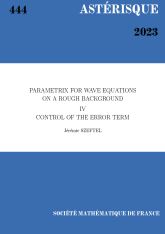- Année : 1992
- Tome : 209
- Format : Électronique
- Langue de l'ouvrage :
Français - Class. Math. : 11T06
- Pages : 115-136
- DOI : 10.24033/ast.158

The higher levels of a field $F$, studied among others by Parnami, Agrawal, Rajwade and Revoy, are defined like the ordinary level, as the smallest number of $n$-th power summands necessary to represent $-1$, where $n$ is a power of 2. When $F$ is a finite field $\mathbb {F}_q$ ($q$ odd), the increasing sequence of higher levels stabilises from $h(q)$ on, where $h(q)$ is the dyadic valuation of $q-1$ ; its supremum is denoted here by $s(q)$. It appears that $s(q) = 2$ unless $q = p$ or $p^3$, with $p =\mathrm {char} F$, and $s(p^3) = 2$ or 3. If $q = p$, the Weil (or Jacobi) sums estimates imply that $s(p) = 2$ as soon as $p > 2^{4h(p)}$. However, computations performed up to $10^9$ hint that this bound is much too big in practice, and at least for small values of $h(p)$ ($h(p)\leq 7$), one has $s(p) = 2$ as soon as $p > 2^{2.72h(p)}$. Similarly, computations find no prime $p$ such that $s(p^3) = 3$ up to $p = 101 711 873$. We believe that these experimental results exemplify general phenomena, but so far have no theoretical explanation for them.

L'abonnement correspond aux 8 volumes annuels : 7 volumes d'Astérisque et le volume des exposés Bourbaki de l'année universitaire écoulée.

This subscription corresponds to 8 volumes: 7 volumes of Astérisque plus one volume with the texts of the Bourbaki talks given in the past year.